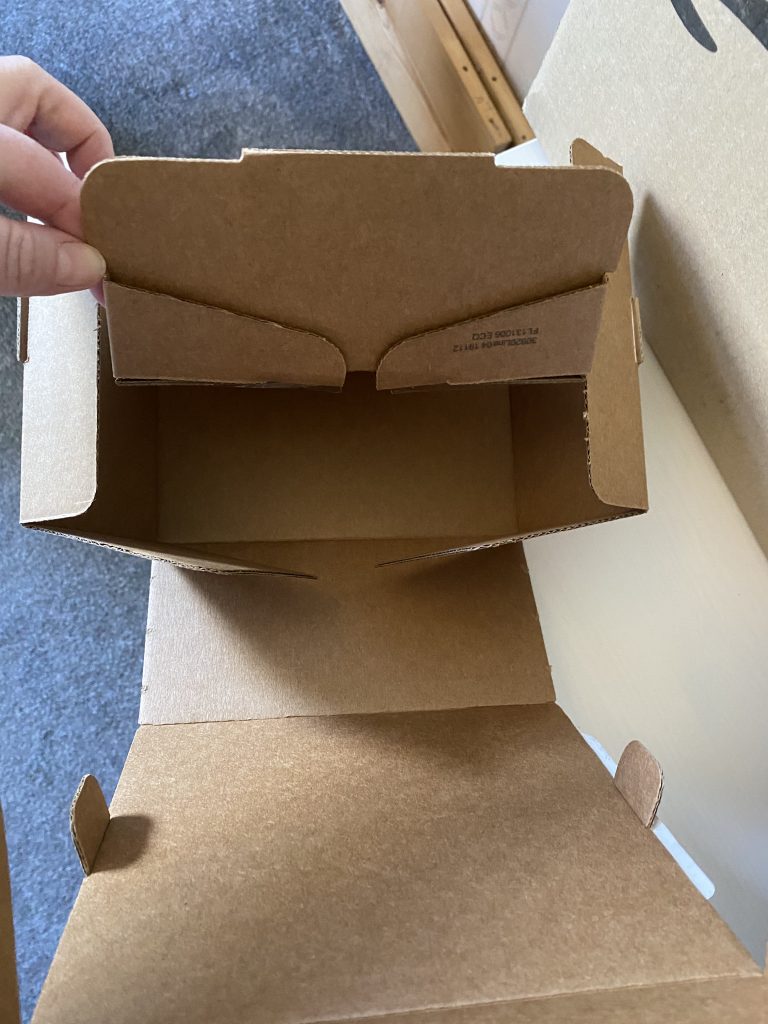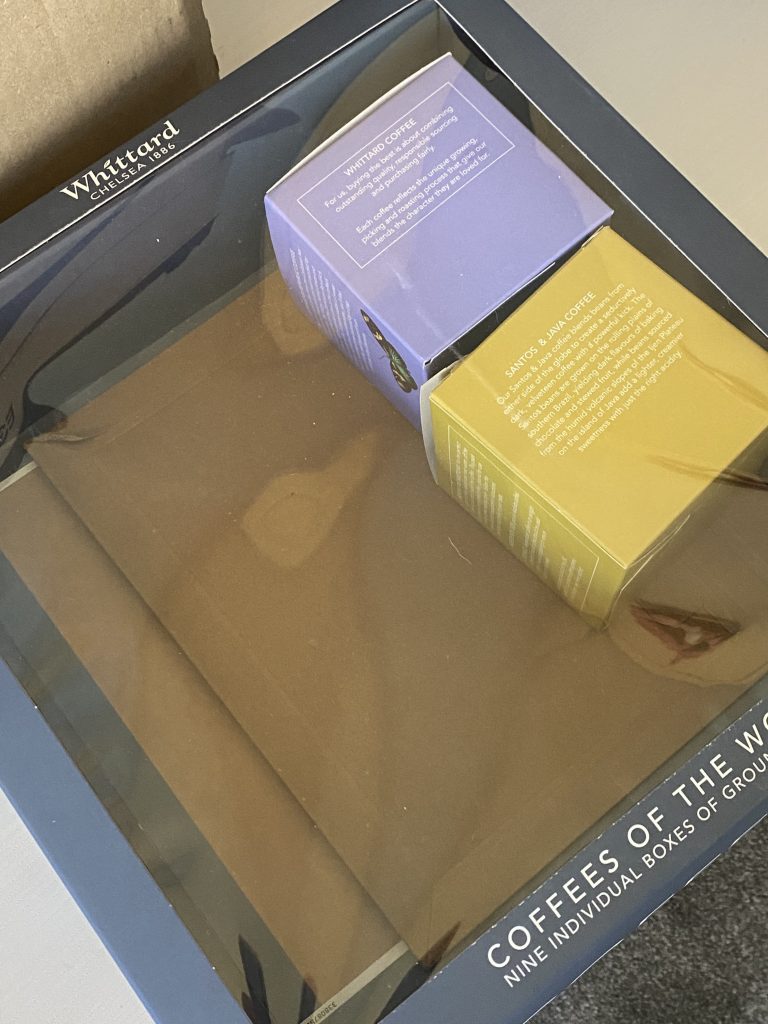Boxes aren’t a requirement for scentwork. The environment will always provide opportunities for hiding scented articles. But adding cardboard boxes to the search environment is a cheap, flexible and smart way to help you set and achieve training goals. But not all boxes are equal. Some provide many more options than others. Today I want to highlight what to look for when deciding which boxes to save and which to consign directly to the recycling bin.
Coming up . . .
Safety first
Let’s get the less desirable boxes out of the way first. As ever, safety comes first. Check for staples or sharp edges that could cut your dog as she searches. Think too about what has been in the box. If it transported clearers, chemicals or anything potential toxic, don’t use it. And consider too if they have contained food. That scent might prove more attractive than the target scent to a novice dog. So only use food containers once your dog is a more experienced scentworker. Remember, we are talking about cheap (so cheap they’re usually free), disposable containers so there’s no issue with discarding those that aren’t 100% safe or appropriate.
Boxes that are not cheap are manufactured scent boxes. You’ll have seen them around. Usually they are cuboids with a hole cut out of one face. The idea is that the trainer sets out a series of identical boxes and the dog searches them by sniffing the openings. The first issue I have with these boxes is that they decrease the options for searching by limiting the dog to searching just these boxes. Right from the start of Talking Dogs Scentwork training, the dog is searching a variety of objects. In our workshops and classes, dogs search cardboard boxes and chairs. At home they most often search around furniture. They do not only search identical (visually) boxes.
Don’t limit variety
Variety is what makes scentwork fun. The unexpected nature of where a scent might be located is key to the flexibility that this activity brings. We are working for pleasure, not training dogs to detect minuscule amounts of target scent on a scent wheel. We are not searching for covid, we’re searching for catnip, for cheese. Limiting the possibilities of what could and could not be a hide at the start simply adds another layer of training that needs to be dispelled at a later stage. If the dog learns that the taggert scent will only be found in a specific type of box, that’s the only place she will search. That’s what has been taught. But if she learns it could be anywhere, she will search everywhere.

Contamination
Another issue I have is that all too often these boxes are wooden. Wood absorbs scent. It absorbs moisture, such as saliva and nasal discharge (runny nose). So how to clean these wooden boxes? If they are being used multiple times, which at over £20 a shout they will be, how to stop or remove contamination? If they’re being used in a class with multiple dogs how do you know if your dog is indicating on the target scent or on the scent of another dog? Or even on her own scent from a previous search? How do you know that your dog isn’t indicating on the target scent when she shows on an ‘empty’ box? That box could have been used before. Just because the trainer hasn’t added the target scent to it this time around doesn’t mean that that it hasn’t been the target box in previous searches.
If you really want to teach your dog to search a line of identical boxes, use disposable cardboard boxes. That way, you can always be sure that contamination is limited because the boxes are only used once. Simple.
Catch 22
Now I’ve got that off my chest, let’s have a look at some great boxes that do provide flexibility and challenge. Boxes with multiple compartments are fab! One of my all time fav boxes had a series of drawers in it, each drawer made up of multiple sections. I loved it so much that I kept it for ages before using it. And that can be an issue with finding a great box. It’s so great that you know once it’s used you’ll have to throw it away. But that does defeat the purpose of keeping it in the first place. Classic Catch 22! Boxes that have held electronics or computer equipment are often wonderful.



For example, the iPhone box below can be used for all skill levels. The box itself is robust. This means that it will hold scent inside it for longer compared to a flimsy box that will quickly absorb the scent and release it into the air. I can make it even more challenging by taping the lid down so that there are no obvious places from which air and scent can escape. Factors that will further impact on how easy or difficult it is for the dog to detect the target scent include how long the article is inside, the size of the article and the material. These three factors will always place a part in your searches.

This box also had multiple compartments. This allows me to hide the article inside and underneath different sections of the box. What I’m doing is adding layers through which the scent had to move. This decreases the scent picture and increases the challenge. I can even leave the old phone in the box. I can use it as another layer, e.g. place the article under the phone. Or I can hide the article in the phone itself by placing it between the phone cover and the phone. Can you see just how many options there are in this one box?
Double shell

Other aspects to look out for are double shells. Here is a box that contained a bottle of champagne. It needed to be robust and strong hence making a box within the box. I can slip an article between the layers of cardboard. Or I can place a scented mouse inside and close the lid to give a learner dog a step up in terms of challenge. Always choose the box and how you’ll use it according to the dog’s skill level, your skill level and your search goals.

This box is a great intermediate box. I realised it’s potential late in the day. As you can see, it contained a series of small boxes. But I only remembered to keep the small boxes at the last minute hence only having two. Nonetheless, this still makes a good hide. I can place the article in the box under the small boxes, or inside one of the small boxes. Or I can add other boxes to it so that it’s full of small boxes.
Even the most basic of boxes can provide excitement and unexpected hides. Slip the scented article underneath the flaps of the box at the top or bottom. For dogs who search for cheese, you can stick the cheese on the outside of the box. For example, sticking the cheese under a flap on the outside of the box can be unexpected for both dog and handler. Always remember, if you can make the search double blind (neither handler nor dog knows where the find is) you will learn so much more than if you place the finds yourself.
Hide from the handler as well as the dog
And if the assistant can hide the article in such a way that the handler can’t see it, that’s ideal. I love it when a handler looks inside a box and dismisses it, but the dog does not. The dog isn’t searching visually so she isn’t blindsided by finds that can’t be seen. This helps the handler learn to read her dog and to trust her indications no matter what preconceptions she has about the location of the hide.
So use boxes to their full advantage. Think about how they can be useful to you in your searches instead of automatically chucking them out. Use them wisely. And then throw them away. Don’t reuse a great box just because it’s a great box. And don’t save boxes that you’ll never use. There is only so much box hoarding that any household can take!




Great blog I’ll definitely look out for really good boxes now ??
Watch out, it’s a slippery slope lol!
Ah the joy of finding a fabulous box and then not being able to bear to use it because it is potentially so wonderful!!! I have several!
The struggle is real!
I’ve been storing boxes since I started my Scentwork journey – much to my husband’s annoyance!! I try to chuck out ones that won’t be any good and just keep the “best” ones, but it’s hard!! ??
It’s so hard. But you never know when you just might need that particular box lol!